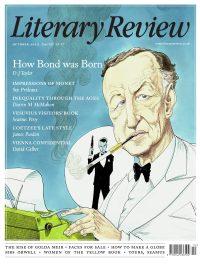Keith Miller
Round Midnight
Cahokia Jazz
By Francis Spufford
Faber & Faber 496pp £20
Readers who don’t observe a very particular literary diet may experience a sinking feeling as they crack open their box-fresh copy of Cahokia Jazz to discover that its opening pages feature not one but two maps. Such an enhancement generally serves to forewarn us that we are entering a realm of the author’s own invention – a useful enough device, under some circumstances, if also an unmistakably passive-aggressive one. Yet the tale that ensues is quite free from dragons, cephalopod philosophers, wisecracking space janissaries, warrior queens in suede bikinis, chrome-plated hitmen and the rest of the genre-fiction repertory company. It’s a moderately hard-boiled – let’s say eight minutes or so – police procedural in what seems, at first acquaintance, to be an archetypal Prohibition-era city of the American Midwest. Two cops – a big beefy one, and a smaller and faintly rat-like one – are on top of a downtown skyscraper in the dead of night, working an unusually messy and disquieting crime scene.
The plot does not then delay in thickening. We start to encounter words in what for most of us will be an unfamiliar language – one of them, ‘Bashli’, daubed in blood on the victim’s forehead. Both our detectives find themselves caught up in the orbit of powerful figures: a wealthy and parodically preppy industrialist, a kind of semi-divine super-mayor known as ‘the Man’ and his enigmatic, aquiline daughter. The larger cop, Barrow, plays a mean piano but can’t quite bring himself to take a leap and give up the day job; the other, Drummond, is haunted by nightmares of a collapsed trench in the First World War and driven on by dreams of owning an orange grove in California, as well as regular doses of what, as Francis Spufford helpfully notes in a longish afterword, we would call crystal meth.
We gradually work out that this is a universe in which the Mississippian civilisations of pre-Columbian America have continued to thrive, becoming a political, cultural and military force across the burgeoning United States. Cahokia, in our own world a rather doleful set of burial mounds ‘east of East

Sign Up to our newsletter
Receive free articles, highlights from the archive, news, details of prizes, and much more.@Lit_Review
Follow Literary Review on Twitter
Twitter Feed
Under its longest-serving editor, Graydon Carter, Vanity Fair was that rare thing – a New York society magazine that published serious journalism.
@PeterPeteryork looks at what Carter got right.
Peter York - Deluxe Editions
Peter York: Deluxe Editions - When the Going Was Good: An Editor’s Adventures During the Last Golden Age of Magazines by Graydon Carter
literaryreview.co.uk
Henry James returned to America in 1904 with three objectives: to see his brother William, to deliver a series of lectures on Balzac, and to gather material for a pair of books about modern America.
Peter Rose follows James out west.
Peter Rose - The Restless Analyst
Peter Rose: The Restless Analyst - Henry James Comes Home: Rediscovering America in the Gilded Age by Peter Brooks...
literaryreview.co.uk
Vladimir Putin served his apprenticeship in the KGB toward the end of the Cold War, a period during which Western societies were infiltrated by so-called 'illegals'.
Piers Brendon examines how the culture of Soviet spycraft shaped his thinking.
Piers Brendon - Tinker, Tailor, Sleeper, Troll
Piers Brendon: Tinker, Tailor, Sleeper, Troll - The Illegals: Russia’s Most Audacious Spies and the Plot to Infiltrate the West by Shaun Walker
literaryreview.co.uk